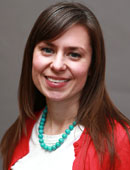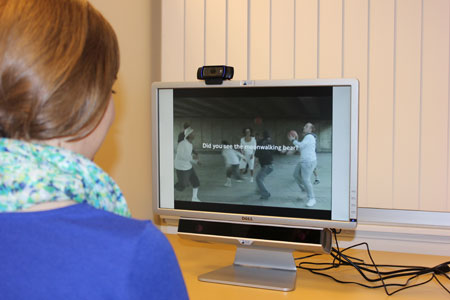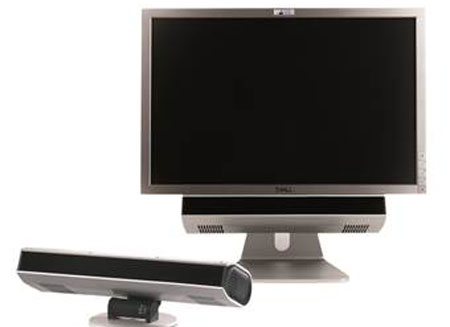Grant provides for infrared eye tracker in CSD
A grant from the National Science Foundation (NSF) that was recently awarded to the Communication Sciences and Disorders Department (CSD) will support research by faculty and students on people with autism, aphasia, and other communication disorders.
CSD has used the funding to purchase new cutting-edge equipment, including an infrared Remote Eye-tracking Device (RED) that can take between 250 and 500 snapshots per second of a person’s eye movement.
The research comes at an important time—a new U.S. Centers for Disease Control study shows one in 68 children have autism.
 Assistant Professor Rhiannon Luyster, one of four CSD faculty members who were awarded the NSF grant, will use the RED to study eye movements in infants and toddlers who may be on the autism spectrum.
Assistant Professor Rhiannon Luyster, one of four CSD faculty members who were awarded the NSF grant, will use the RED to study eye movements in infants and toddlers who may be on the autism spectrum.
“Examining the focus of [a research subject’s] attention is something that can be really, really valuable,” Luyster said. “They might not be able to tell you what they’re focusing on…but now you have real-time measurement.”
Professor Daniel Kempler, Associate Professor Joanne Lasker, Assistant Professor Ruth Grossman, and Luyster all collaborated to apply for the NSF grant.
The eye tracker will be housed in a new lab space at 216 Tremont Street, and is available for research projects conducted by students, faculty, and staff of any academic department. A primary goal of the NSF-funded research is to encourage interdisciplinary work, as well as disseminate grant-related research findings to the general public.
Luyster said the eye-tracking device could be helpful for Marketing Communication students conducting research studies, for example.
The researchers who brought the NSF grant to Emerson have made a connection with Science Club for Girls and will host a field trip in May for several of their students to use the eye tracker—and have other hands-on experiences—to learn about scientific research careers in the field of communication disorders and cognitive sciences.
RED, which is made by SensoMotoric Instruments, Inc., in Boston, consists of two main parts: a computer monitor, which can display any image or video, and the infrared tracker that detects a person’s eye movement.

Research assistant Sandra Buck demonstrates how the RED infrared eye-tracking system is used with clients. The long, horizontal device below the screen takes between 250 and 500 snapshots per second of a person’s eye movement. (Photo by Dan O’Brien)
Luyster said the real-time eye-gaze measurement might be helpful in autism treatment planning for young children.
“We hope to use this information to modify what you should be doing in early intervention,” said Luyster, adding that she is particularly interested in seeing how often a toddler with autism is looking at a person’s moving mouth during language development.
Kempler and Lasker will use the RED to study adults with speech and communication problems due to aphasia or other medical conditions. Aphasia is an acquired language disorder that may occur after a stroke.
Kempler and Lasker said their research will focus on how often adults with aphasia focus on hand gestures and other nonverbal cues, especially when they are having difficulty understanding another person who is speaking.

An image of a Remote Eye-tracking Device provided by SensoMotoric Instruments Inc. of Boston.
“One project will track their eye movements during listening to evaluate if people will focus on the verbal channel, or look at the hands, or somewhere else entirely,” Kempler said. “This information will help us understand both the nature of the problem and ways to optimally intervene.”
Grossman, who is studying adolescents on the autism spectrum, will use the eye tracker to collect data on how adults who are not autistic gather information from the facial expressions of children and adolescents on the autism spectrum.
Grossman is also using Emerson’s second new RED in her new Facial Affective and Communicative Expressions (FACE) Lab on the second floor of the State Transportation Building to examine the eye movements of adolescents on the autism spectrum. This eye tracker, as well as the lab space, a postdoctoral fellow position, and other costs associated with it, is being funded by a separate grant from the National Institutes of Health.
Categories